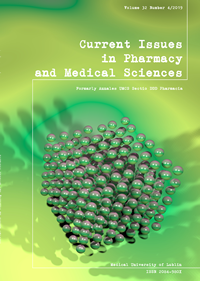Comparative dissolution studies on granules with acetaminophen and caffeine using the basket and paddle methods with simultaneous spectrophotometric determination of active substances
DOI:
https://doi.org/10.2478/cipms-2019-0037Keywords:
caffeine, acetaminophen, granules, basket apparatus, paddle apparatus, dissolutionAbstract
Acetaminophen and caffeine, popular therapeutic substances used to relieve pain or alleviate the symptoms of cold. The aims of the study were the comparison of granules, in terms of dissolution rate and moreover the development of spectrophotometric method to the simultaneous determination of both active pharmaceutical ingredients (APIs) in granules. The granules were tested by two pharmacopoeial methods of dissolution for solid dosage forms, and the dissolution profiles for each formulation were compared. A method of simultaneous determination of two medicinal substances by the double calibration method using derivative spectrophotometry was used. Considering the dissolution process carried out in the paddle apparatus, it was shown that more than 80% of acetaminophen and caffeine were released from each of the preparations in a clearly shorter time than 10 minutes. Carrying out the basket test, substances dissolved gradually, much slower than in the paddle method. The time required to release 80% of both active substances from majority of tested preparations was from 30 to 45 minutes. Application of the first derivative spectrophotometric method allows simultaneous determination of acetaminophen and caffeine in the mixture, without the need to separate them first.
References
1. Sznitowska M. (ed.) Farmacja stosowana. Technologia postaci leku. Warsaw: PZWL; 2017:229-51 (in Polish).
2. Szumilo M, Belniak P, Swiader K, Holody E, Poleszak E. Assessment of physical properties of granules with acetaminophen and caffeine. Saudi Pharm J. 2017;25(6):900-5.
3. The Polish Pharmacopeia. 6th ed., The Minister of Health (PL), Warsaw; 2002:323-4,554 (in Polish).
4. Sokol A, Karpinska J, Talecka R, Starczewska B. Quantification of ranitidine hydrochloride in the presence of its decomposition product by spectrophotometric methods. Application for kinetic study. Acta Pol Pharm Drug Res. 2011;68(2):169-77.
5. Vichare V, Mujgond P, Tambe V, Dhole SN. Simultaneous spectrophotometric determination of paracetamol and caffeine in tablet formulation. Int J PharmTech Res. 2010;2(4):2512-6.
6. The European Pharmacopoeia. 9th ed., The Council of Europe (EU), Strasbourg; 2017:429-34.
7. Chevalier E, Viana M, Artaud A, Chomette L, Haddouchi S, Devidts G, et al. Comparison of three dissolution apparatuses for testing calcium phosphate pellets used as ibuprofen delivery systems. AAPS PharmSciTech. 2009;10(2):597-605.
8. Kraciuk R, Sznitowska M. Effect of different excipients on the physical characteristics of granules and tablets with carbamazepine prepared with polyethylene glycol 6000 by Fluidized Hot-Melt Granulation (FHMG). AAPS PharmSciTech. 2011;12(4):1241-7.
9. Hori S, Kawada T, Kogure S, Yabu S, Mori K, Akimoto M. Comparative release studies on suppositories using the basket, paddle, dialysis tubing and flow-through cell methods I. Acetaminophen in a lipophilic base suppository. Pharm Dev Tech. 2017;22(1):130-5.
10. Skripnik K, Riekes M, Pezzini B, Cardoso S, Stulzer H. Investigation of the dissolution profile of gliclazide modified-release tablets using different apparatuses and dissolution conditions. AAPS PharmSciTech. 2017;18(5):1785-94.
11. Todaro V, Persoons T, Grove G, Healy A, D’Arcy D. Characterization and simulation of hydrodynamics in the paddle, basket and flow-through dissolution testing apparatuses – a review. Diss Tech. 2017;24(3):24-36.
Downloads
Published
Issue
Section
License
Copyright (c) 2019 Autors

This work is licensed under a Creative Commons Attribution-NonCommercial-NoDerivatives 3.0 Unported License.


